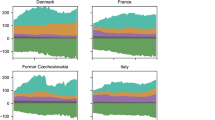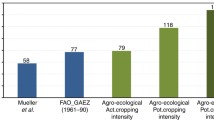Abstract
In assessing the future prospects of any crop, it is sensible to consider what factors contribute to the crop’s present position and how these are likely to change, if at all, in the immediate and near future. The considerations tend predominantly to be economic in that the output from producing the crop must be commensurate with the input, though the input may not always be easy to quantify in purely monetary terms. Economic viability needs to be assessed by a broad and open-minded economist, not by an accountant who will tend to ignore what cannot be expressed in cash terms.
Access this chapter
Tax calculation will be finalised at checkout
Purchases are for personal use only
Preview
Unable to display preview. Download preview PDF.
Similar content being viewed by others
References
Archer, T.C. (1853) Popular Economie Botany, Reeve, London,
Gregory, W.C., Smith, B.W. and Yarbrough, J.A. (1951) Morphology, genetics and breeding, in The Peanut — the Unpredictable Legume, National Fertilizer Association, Washington DC, pp. 28–88.
Harlan, J.R. and de Wet J.M.J. (1971) Toward a rational classification of cultivated plants. Taxon, 20, 509–517.
Hemingway, J.S. (1957) The resistance of groundnuts to Cercospora leaf-spots. Empire Journal of Experimental Agriculture, 25, 60–68.
Hildebrand, G.L. and Smartt, J. (1980) The utilization of Bolivian groundnut (Arachis hypogaea L.) germplasm in Central Africa. Zimbabwe Journal of Agricultural Research, 18, 39–48.
Johnson, F.R. (1964) The Peanut Story, Johnson Publishing Co., Murfreesboro, North Carolina.
Klozová, E., Svachulová, Smartt, J. et al. (1983a) The comparison of seed protein patterns within the genus Arachis by Polyacrylamide gel electrophoresis. Biologia Plantarum, 25, 266–272.
Klozová, E., Turková, V., Smartt, J. et al. (1983b) Immunochemical characterization of seed proteins of some species of the genus Arachis L. Biologia Plantarum, 25, 201–208.
Kochert, G., Halward, T., Branch, W.D. and Simpson, C.E. (1991) RFLP variability in peanut (Arachis hypogaea L.) cultivars and wild species. Theoretical and Applied Genetics, 81, 565–570.
Krapovicakas, A. (1969) The origin, variability and spread of the groundnut (Arachis hypogaea), in The Domestication and Evolution of Plants and Animals, (eds P.J. Ucko and G.W. Dimbleby), Duckworth, London, pp. 427–441.
Nigam, S.N. (ed.) (1992) Groundnut — a global perspective. Proceedings of an International Workshop 25–29 November 1991 ICRISAT Centre. ICRISAT, Pantancheru, Andra Pradesh, India, pp. 375–378.
Resslar, P.M. (1980) A review of the nomenclature of the genus Arachis L. Euphytica, 29, 813–817.
Rick (in press) in Smartt, J. and Simmonds, N.W. (eds) Evolution of Crop Plants (2nd edn) Longman, London.
Singh, A.K. (1988) Putative genome donors of Arachis hypogaea (Fabaceae), evidence from crosses with synthetic amphidiploids. Plant Systematics and Evolution, 160, 143–151.
Smartt, J. (1978) Makulu Red — a ‘Green Revolution’ groundnut variety. Euphytica, 27, 605–608.
Smartt, J., Gregory, W.C. and Gregory, M.P. (1978) The genomes of Arachis hypogaea L. 1. Cytogenetic studies and putative gene donors, Euphytica, 27, 665–675.
Stalker, H.T. (1991) A new species in section Arachis of peanuts with a D genome. American Journal of Botany, 78, 630–637.
Stalker, H.T. (1992) Utilizing Arachis germplasm resources in Groundnut — a Global Perspective, (ed. S.N. Nigam), ICRISAT, Patancheru, A.P., India, 281–295.
York, E.T. and Colwell, W.E. (1951) Soil properties, fertilization and maintenance of soil fertility, in The Peanut — the Unpredictable Legume. National Fertilizer Association, Washington DC, pp. 122–172.
Editor information
Editors and Affiliations
Rights and permissions
Copyright information
© 1994 Springer Science+Business Media Dordrecht
About this chapter
Cite this chapter
Smartt, J. (1994). The future of the groundnut crop. In: Smartt, J. (eds) The Groundnut Crop. World Crop Series. Springer, Dordrecht. https://doi.org/10.1007/978-94-011-0733-4_17
Download citation
DOI: https://doi.org/10.1007/978-94-011-0733-4_17
Publisher Name: Springer, Dordrecht
Print ISBN: 978-94-010-4315-1
Online ISBN: 978-94-011-0733-4
eBook Packages: Springer Book Archive




